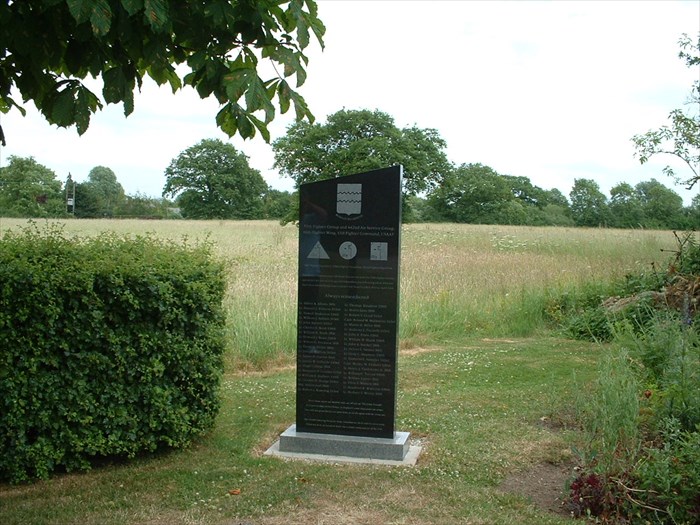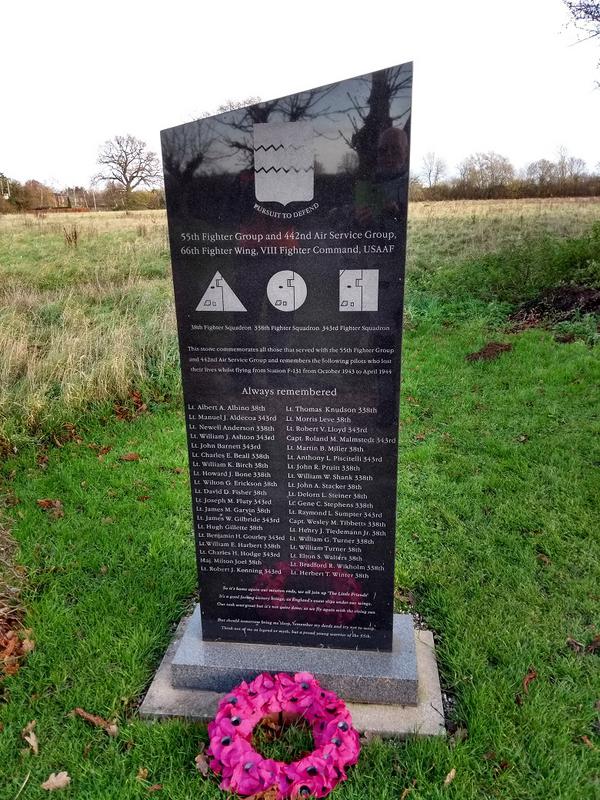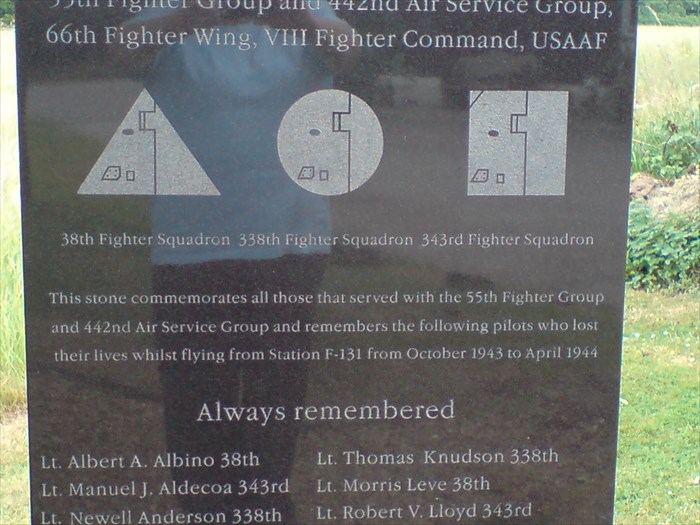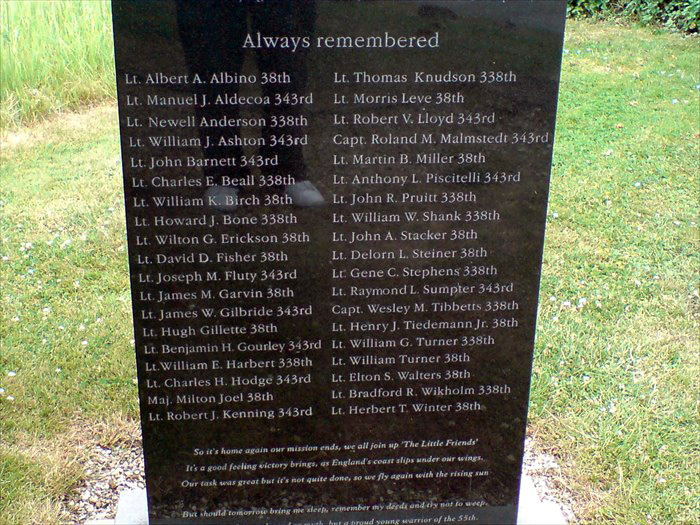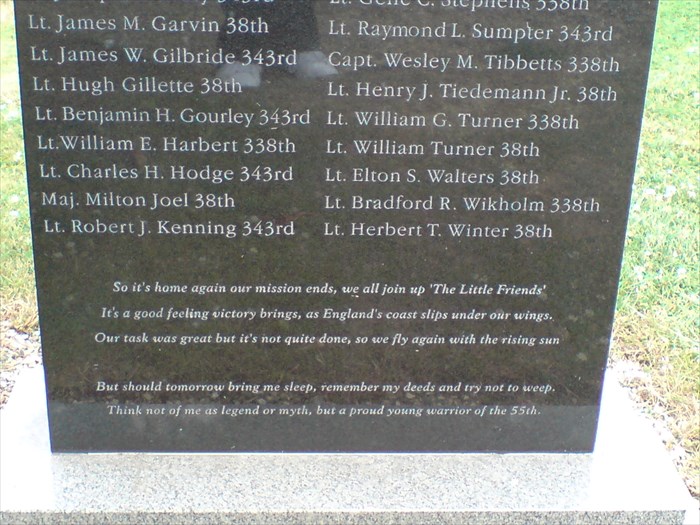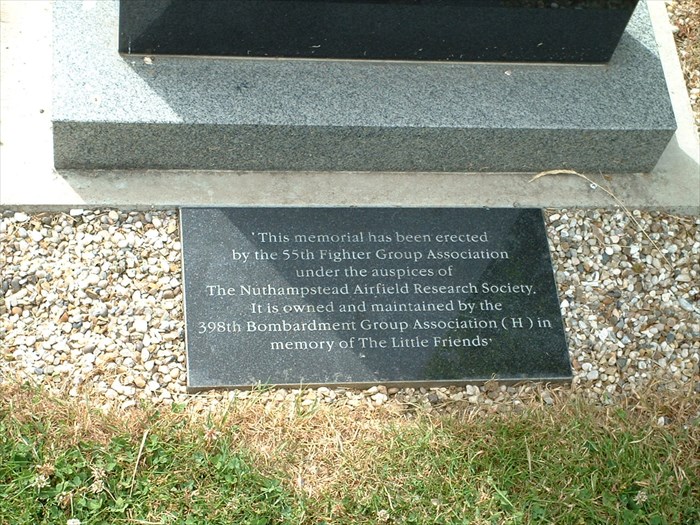55th Fighter Group Monument
Details:
On the north side next to the Woodman Inn, near the 398th Bombardment Group monument. Both memorials are sited adjacent to the Woodman Inn, a hostelry that would have been used by members of both the 398th and 55th Groups. The plot is a slightly raised mound. The mound is grassed with a gravel path between the monuments and a small bench. There is a hedge behind the monument plot and the entrance to the Woodman Inn to the front.
An upright, black marble stone, set on a small 2 stepped base, with a sloping top. The monument is inscribed with a dedication message followed by a list of names in 2 columns who died while stationed at RAF Nuthampstead. Depicted images on the top of the monument are the 55th Fighter Group insignia and crests of the 38th, 338th, and 343rd Fighter Squadron. The memorial was unveiled on June 7, 2006. There is another plaque at the foot on the rear which contains the erection information for the monument.
Although the airfield was built to accommodate heavy bombers, from September 1943 until April 1944 the 55th Fighter Group used the airfield, arriving from McChord AAF Washington on 14 September 1943. The group was under the command of the 67th Fighter Wing of the VIII Fighter Command. Aircraft of the 55th were identified by a green/yellow checkerboard pattern around their cowlings.
The group consisted of the following squadrons:
- 38th Fighter Squadron (CG)
- 338th Fighter Squadron (CL)
- 343d Fighter Squadron (CY)
The 55th FG began operations with Lockheed P-38H Lightning on 15 October 1943 and was the first to use these aircraft on long-range escort missions from the UK. The P-38H differed from earlier versions in being powered by 1425 hp Allison V-1710-89/91 engines.
The Lightning' engines were troubled by the addition of alcohol used as an anti-knock compound in their fuel supply; a British war economy solution that caused problems with water condensation on the ground and fuel line icing at altitude. Another British attempt to correct fuel composition caused lead metal deposits to coat cylinders and foul plugs throughout the squadron. The -H series Lightning did not have adequate cooling for extended high-power usage, as their engine development had outstripped the cooling capacity of the integral intercooler which ran through the wing's leading edge. Pilots were instructed to restrict their periods of highest engine power to defined time limits, but many did not. As a result of these various influences, the Group's Lightning suffered a high rate of attrition. Nevertheless, 55FG P-38H pilots provided cover for missions against aircraft plants during Big Week in February 1944. Lt. Col. Jack Jenkins led the group on 3 March 1944, when they became the first Allied fighters to reach Berlin on an escort mission.
On April 16, 1944, the group moved to RAF Wormingford in Essex to accommodate the arrival of the 398th Bomb Group. The 55FG converted to North American P-51D Mustangs in July 1944, continuing their primary task of escorting Boeing B-17 Flying Fortress and Consolidated B-24 Liberator bombers that attacked such targets as industries and marshaling yards in Germany, and airfields and V-weapon sites in France.
Source of information: www.warmemorialsonline.org.uk, Imperial War Museum War Memorials Register, en.wikipedia.org, geograph.co.uk
Source of photos: Imperial War Museum War Memorials Register, geograph.co.uk
Monument Text:
Front:
(-GROUP CREST-)
55th Fighter Group and 442nd Air Service Group
66th Fighter Wing, VIII Fighter Command, USAAF
(-3 SQUADRON CRESTS-)
38th Fighter Squadron 338th Fighter Squadron 343rd Fighter Squadron
This stone commemorates all those that served with the 55th Fighter Group
and 442nd Air Service Group and remembers the following pilots who lost
their lives whilst flying from Station F-131 from October 1943 to April 1944
Always remembered
|
Lt. Albert A. Albino 38th Lt. Manuel J. Aldecoa 343rd Lt. Newell Anderson 338th Lt. William J. Ashton 343rd Lt. John Barnett 343rd Lt. Charles E. Beall 338th Lt. William K. Birch 38th Lt. Howard J. Bone 338th Lt. Wilton G. Erickson 38th Lt. David D. Fisher 38th Lt. Joseph M. Fluty 343rd Lt. James M. Garvin 38th Lt. James W. Gilbride 343rd Lt. Hugh Gillette 38th Lt. Benjamin H. Gourley 343rd Lt.William E. Harbert 338th Lt. Charles H. Hodge 343rd Maj. Milton Joel 38th Lt. Robert J. Kenning 343rd |
Lt. Thomas Knudson 338th Lt. Morris Leve 38th Lt. Robert V. Lloyd 343rd Capt. Roland M. Malmstedt 343rd Lt. Martin B. Miller 38th Lt. Anthony L. Piscitelli 343rd Lt. John R. Pruitt 338th Lt. William W. Shank 338th Lt. John A. Stacker 38th Lt. Delorn L. Steiner 38th Lt. Gene C. Stephens 338th Lt. Raymond L. Sumpter 343rd Capt. Wesley M. Tibbetts 338th Lt. Henry J. Tiedemann Jr. 38th Lt. William G. Turner 338th Lt. William Turner 38th Lt. Elton S. Walters 38th Lt. Bradford R. Wikholm 338th Lt. Herbert T. Winter 38th |
So it’s home again our mission ends, we all join up ‘The Little Friends’
It’s a good feeling victory brings, as England’s coast slips under our wings.
Out task was great but it’s not quite done, so we fly again with the rising sun.
But should tomorrow bring me sleep, remember my deeds and try not to weep.
Think not of me as legend or myth, but a proud young warrior of the 55th.
Rear Plaque:
‘This memorial has been erected
by the 55th Fighter Group Association
under the auspices of
The Nuthampstead Airfield Research Society.
It is owned and maintained by the
398th Bombardment Group Association (H) in
memory of The Little Friends’
Commemorates:
People:
Benjamin Harrison, Jr. Gourley
Units:
338th Fighter Squadron, 55th Fighter Group
343rd Fighter Squadron, 55th Fighter Group
389th Bomber Group (Heavy)
38th Fighter Squadron, 55th Fighter Group
442nd Air Service Group
55th Fighter Group
66th Fighter Wing
8th Air Force
US Army Air Corps
Wars:
WWII
Other images :

